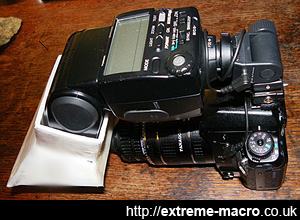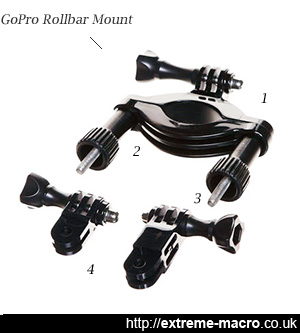The Horizontal Flash
by Johan J Ingles-Le Nobel
Last updated August 31, 2017
People most commonly use a flash bracket with a flash rigged on this angled towards the subjects for their extreme macro, but having tried and tested various brackets I ended up using horizontal flash setup.
Why Horizontal?
This horizontal setup works because the flash is very near the subject so you have more manoeuvrability, sharper shots, faster flash recharge and longer lasting batteries. It is also smaller, so you can fit between leaves and branches et. The simplest and most effective field setup for non MPE users that I could manage at the time.

Horizontal flash setup for extreme macro. Rather than having the flash sit on an arm fixed to the camera, I opted to lean the flash over the subject. This setup uses adjustable shoe mounts and PC-sync with manual flash mode, although nowadays I use a Nissin SC-01 universal off camera shoe cord to allow the use of rear curtain sync.
The horizontal setup works well because the flash is very near the subject so you need to use far less battery power, which means longer lasting batteries and much faster flash recharge times.
Manoeuvrability
The first good reason to use a horizontal flash setup is its manoeuvrability, especially when shooting small insects in the field that are amidst branches, stalks and leaves.
My experience of trying to get a large bracket-arm mounted flash unit and DSLR into such spaces has been less than fruitful as I usually have one of two issues.
Either the blasted flash arm contraption is just too big and you can't get into where you want to get, or the sheer size of the whole contraption means that the insect spots you and casually flies away. Neither is desirable in extreme macro.
Recharge
When I'm shooting outside I like to approach the insect and shoot several shots when I'm nearly in focus to make extra sure that at least one in the sequence will be nice and sharp. We're dealing with fractions of a millimetre sharp focal plains, so overshooting can be forgiven.
more manoeuvrability, sharper shots, faster flash recharge and longer lasting batteriesPart of the consequence of this is that you want a decent macro flash that recharges as fast as possible, and by having a flash head much closer to the subject than on a big old arm it means that you can use a lower power speed, which not only makes for a faster flash duration (so sharper extreme macro photos) but also means the flash will recharge faster.
The downside is that all the light comes from the top, not the sides or the bottom.
Batteries
Longer lasting batteries are always welcomed by flash shooters and I am no exception. Using the flash at the lower power settings means the batteries last longer. If I can I like to use the flash at a fixed manual setting but sometimes I'll use rear sync to avoid the dreaded phenomenon of flash ghosting. But being able to get off more pops with shorter recharging times is a great result!
Horizontal Flash Construction

GoPro 'rollbar mount', used as parts for a my old "flash cage". 1 and 2 fit round and straddle onto the extension tubes with 1 at the bottom. The steel bolts 3 are replaced with much longer ones of the same gauge. I then cut off some drainpipe and put holes in it to make a U shaped support for the flash. The spare GoPro parts eventually went towards a torch mount which attached to the bottom.
For this setup, a flash is connected to the camera with a Nissin SC-01 universal off camera shoe cord to allow the use of rear curtain sync, and the flash itself, usually a Metz 58, sits inside a custom flash 'cage' made using GoPro parts, nuts, bolts and bits of drainpipe. The illustration at the top is last year's model which used a Pentax flash and PC-Sync.
Diffusion
This is a seperate topic on its own and a variety of differnt materials give different diffusion properties. Tissue paper, polystyrene, vellum paper, tracing paper, laminating sheets, styrofoam amd milk bottle plastic all work, but give different colour casts and light blockage. Shape matters as well - concave is better because there's no difference in light intensity because of light falloff.
Related Articles





